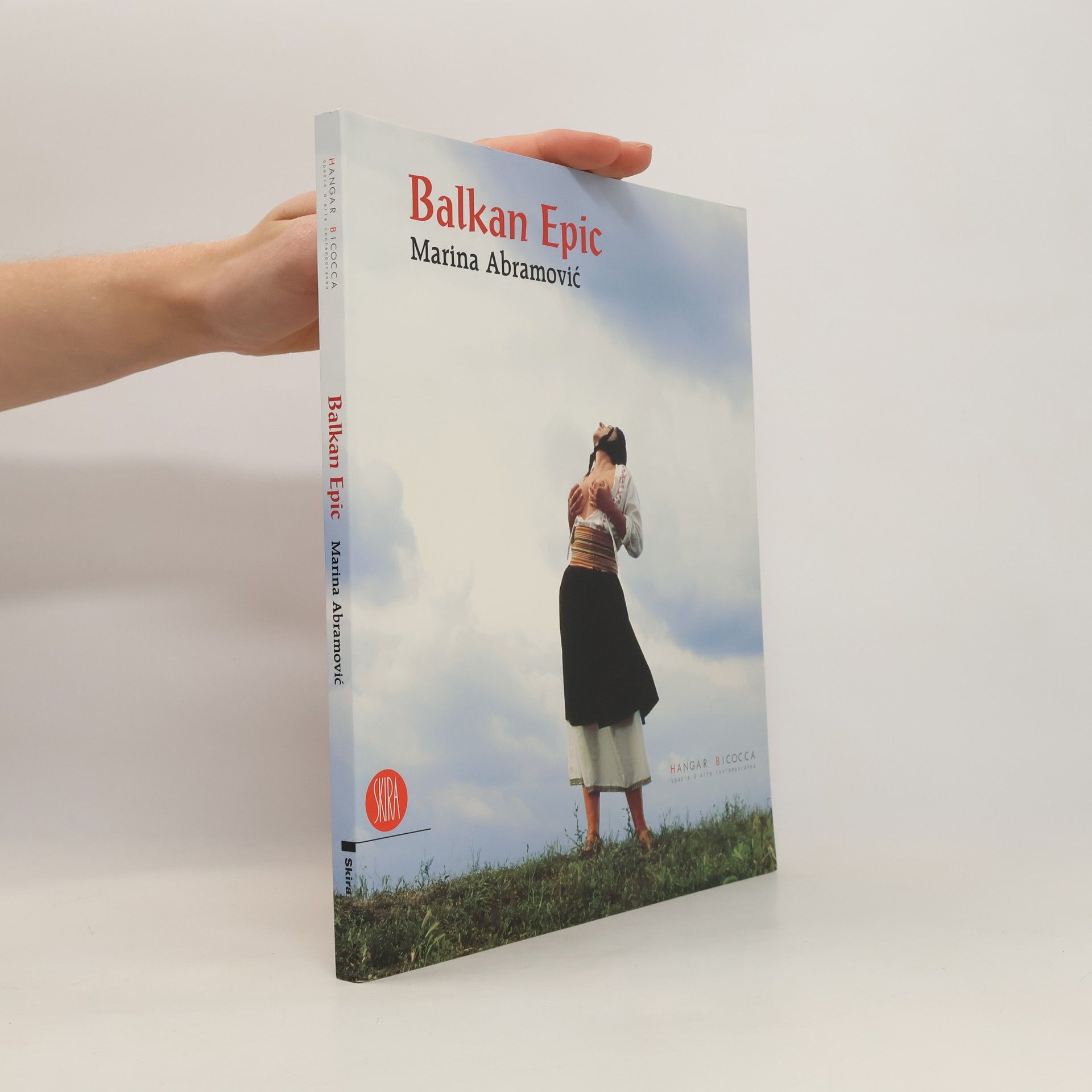The Marina Abramovic Method: Instruction Cards to Reboot Your Life
- 30 pages
- 2 hours of reading
The Abramovic Method will surmount any creative barrier and refocus your life.
Marina Abramović pioneered performance as a visual art form, exploring the limits of the human body and mind. Her works, often ritualistic in nature, delve into themes of pain, exhaustion, and self-transcendence in pursuit of emotional and spiritual transformation. A significant period of collaboration with Ulay (1975–1988) focused on the dynamics of duality, followed by her continued success in solo endeavors. Abramović founded the Marina Abramović Institute (MAI) as a platform for immaterial and long durational work, fostering interdisciplinary collaboration.






The Abramovic Method will surmount any creative barrier and refocus your life.
Mit diesen 30 Karten mit Anleitungen von Marina Abramović erlernen Sie die Methode, mit der die weltbekannte Künstlerin selbst nach einem höheren Bewusstsein strebt und den Herausforderungen des Lebens begegnet. Die Methode besteht aus den Übungen, die Marina Abramović entwickelt hat, um sich auf ihre legendären Performances vorzubereiten. Sie hilft auch Ihnen, sich zu konzentrieren, mit dem Hier und Jetzt wieder in Kontakt zu treten und Ihr volles kreatives Potenzial zu entdecken und es zu nutzen. Enthält ein Booklet mit beschreibenden Texten und Werken der Künstlerin - 30 Karten mit Anleitungen zu jeder Übung - Von einer populären Künstlerin, die mit provozierenden Performances weltweit von sich reden macht. 30 farbig illustrierte Karten mit Booklet in Box.
Die Schriftensammlung versammelt handschriftliche und maschinengeschriebene Notizen, Tagebucheinträge, Gedichte, Traumberichte, Reisebeschreibunge, Briefe, Anweisungen für Performances, Erzählungen, Konzepte, Ideen und Sammlungen von Dokumenten aus dem unerschöpflichen Archiv Marina Abramović’s und erlaubt so unerwartete und tiefe Einblicke in das Schaffen einer Künstlerin, die vor allem für ihre radikalen Performances bekannt ist und im Laufe einer über 50 Jahre umspannenden Karriere mit ihrer immateriellen Kunst ein breites Publikum erreicht.
Marina Abramović has pioneered performance as a visual art form. She created some of the most important early works in this practice, including Rhythm 0 (1974), in which she offered herself as an object of experimentation for the audience, as well as Rhythm 5 (1974), where she lay in the centre of a burning five-point star to the point of losing consciousness. These performances married concept with physicality, endurance with empathy, complicity with loss of control, passivity with danger. They pushed the boundaries of self-discovery, both of herself and her audience. They also marked her first engagements with time, stillness, energy, pain, and the resulting heightened consciousness generated by long durational performance. The catalogue provides a unique insight into the artist’s working method and reflections. It is devoted to more than 50 years of drawings, sketches, thoughts, dreams and ideas produced in Abramović’s hand, and demonstrates the artist’s methodological approach. The book thus provides valuable insight into the processes that provide further background knowledge on her performance and communal works.
Die Publikation zur ersten Retrospektive von Marina Abramovic in Europa bietet einen umfassenden Überblick über ihr Werk der frühen Jahre bis heute: Film, Photographie, Malerei, Objekte, Installationen und Archivmaterial.
Co máme na mysli, keď hovoríme o telách v divadle? Telo je neoddeliteľnou súčasťou divadelnej produkcie a ovplyvňuje spôsob, akým ju vníma obecenstvo. Publikácia skúma komplexný vzťah medzi divadlom a telesnosťou, pričom sa opiera o príklady súčasného divadelného umenia. Odhaľuje napätia medzi telesnosťou, konkrétnymi telami, jazykom a pohybom v divadle. „Táto kniha presne odhaľuje, ako dnes uvažujeme o tele,“ hovorí Marina Abramović. Edícia zahŕňa sériu knižiek, ktoré skúmajú interdisciplinárnu energiu divadla a performancie, kladú otázky o vzájomných súvislostiach medzi divadlom a svetom. Každú knihu napísala významná osobnosť z oblasti divadelnej vedy, ktorá sa zaoberá kritickým myslením v tejto disciplíne. Colette Conroy, prednášajúca teóriu drámy na Royal Holloway, sa zameriava na znevýhodnenie v aplikovanom divadle. Jana Juráňová, spisovateľka a prekladateľka, preložila dielo viacerých významných autoriek a je spoluzakladateľkou feministického projektu ASPEKT. V súčasnosti pracuje aj v Divadelnom ústave ako redaktorka.
Autobiografie
Die Autobiografie – zum 70. Geburtstag am 30. November 2016 Sie hat die Grenzen der Kunst gesprengt: sich gepeitscht, mit einer Glasscherbe ein Pentagramm in den Bauch geritzt, ein Messer in die Finger gerammt. Sie ist 2500 Kilometer auf der Chinesischen Mauer gegangen, zwölf Jahre in einem umgebauten Citroën-Bus durch die Welt gefahren und hat ein Jahr bei den Aborigines in Australien gelebt. Spätestens seit »The Artist is Present« – ihrer berühmten Performance 2010 im New Yorker Museum of Modern Art - gilt Marina Abramović in der ganzen Welt als Kultfigur. Robert Redford schwärmt für sie genauso wie Lady Gaga. Vom »Time Magazine« wurde sie zu den 100 wichtigsten Menschen des Jahres 2014 gewählt. In ihren Memoiren blickt Abramović zurück auf sieben Lebensjahrzehnte als charismatische Künstlerin und Grenzgängerin. Von ihrer strengen Kindheit im kommunistischen Jugoslawien, wo sie bei ihren der politischen Elite nahestehenden Eltern im Schatten Titos aufwuchs – bis hin zu ihren jüngsten Aktionen, bei denen sie die Seele von Millionen von Menschen mit der Kraft ihres Schweigens berührte. Ausstattung: Mit 141 Schwarz-weiß-Fotos und 16 Seiten Farbbildteil
The child of Communist war-hero parents under Tito's regime in postwar Yugoslavia, Marina Abramović was raised with a relentless work ethic. Even as she was beginning to build an international artistic career, she lived at home under her mother's abusive control, strictly obeying a 10 p.m. curfew. But nothing could quell her insatiable curiosity, her desire to connect with people, or her distinctly Balkan sense of humor -- all of which informs her art and her life. Marina's story, by turns moving, epic, and dryly funny, is a vivid and powerful rendering of the unparalleled life of an extraordinary artist --
A selection of artworks by international artists dealing with the food theme and all its implications. This volume accompanies the international traveling exhibition FOOD, that focuses on the preservation of Earth and food choices, as well as the effects of climate change, the poisoning of agricultural products, the food distribution gap, famine, and other related concerns.